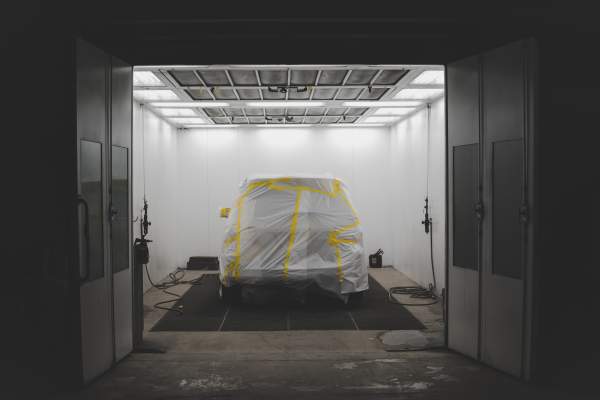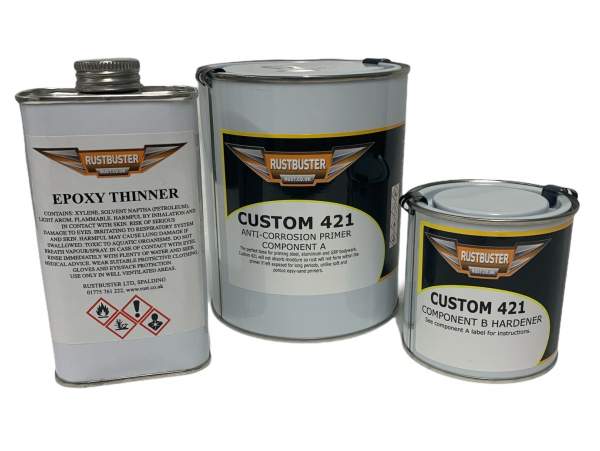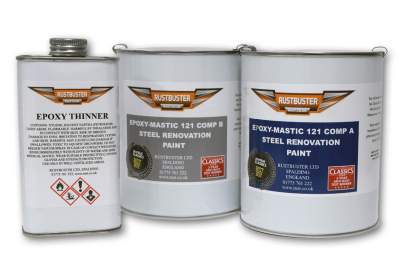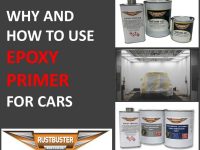When painting car body panels, the obvious choice for primer will be a standard two-pack urethane primer. But although this is fine for professional body shops, it can create significant corrosion problems for the DIY enthusiast. Using an epoxy primer for cars is the solution.
Why is regular body primer prone to corrosion?
Regular urethane 2K body primer can create a big problem for the DIY user. It is porous, so it won’t protect the metal from the combination of water and oxygen that leads to corrosion. Its purpose is to act as a type of bonding agent between metal and topcoat – not to provide anti-corrosion protection.
The result is that car body panels can show signs of rust within a week or two of applying a urethane primer. The same is true of single pack aerosol primers, which are also often porous.
This is not a problem for professional body shops who typically apply the topcoat within a day or so of the primer. Keeping the application time down between primer and topcoat is how they avoid flash rusting on panels. But for the rest of us, it’s a different story.

Corrosion on primed panels is a serious problem for DIY users
For anyone painting at home, there are often long delays between applying the primer and topcoat. This is especially true on a restoration where you’re working on one panel at a time. This delay means it is likely that you’ll see corrosion before you have a chance to apply the topcoat. It’s a real problem, and adds time, effort and cost to the project.
To make matters worse, your vehicle is likely stored in a garage with no expensive dehumidifiers to maintain a low-moisture atmosphere. Even worse, you may be forced to move the vehicle in and out of the garage due to space limitations. Your freshly primed panels are therefore frequently subject to damp environments.
The solution: non-porous epoxy primer for cars
You can avoid the problem of corrosion on primed body panels by using a non-porous epoxy primer for cars. When you prime with an epoxy primer paint, moisture and oxygen will not reach the metal once the primer has been applied.
This non-porous property means there is almost no likelihood of corrosion on your body panels, even if there’s a few months’ delay before applying a topcoat. That’s true even if the panel is stored in a damp atmosphere, including outdoors.
In addition to the non-porous qualities of epoxy primer paint, it also offers excellent adhesion to bare metal and existing paint. Filler can also be applied onto epoxy primer, sanded and repainted in the regular way.
An example of an automotive epoxy body primer
Rustbuster’s Custom 421 Epoxy Primer is a professional-quality body primer paint for steel, aluminium and GRP bodywork. Available in grey or oxide red, it offers high-build performance and all the non-porous benefits of epoxy primer.

Custom 421 has other benefits for the home-user. It can be applied by spray, brush or roller, will cure at temperatures as low as 5°C, and works well with traditional body filler. You can achieve a great surface prior to applying a single pack or two pack cellulose/polyurethane topcoat, Rustbuster Protect UVR High Gloss Topcoat, or rubberised finishes etc.
Follow the normal procedure you would for any primer, including cleaning the surface to remove any grease or other contaminants. Light surface rust on steel can be removed with Rustbuster Phos-Kleen B. This is a phosphating surface preparation chemical that prevents further rusting of the bare metal until you are ready to apply your primer.
When using Custom 421, you will find that it has excellent compatibility with regular body filler. Correct any surface imperfections with filler after the initial coat of Custom 421, sand and feather the edges, then apply Custom 421 again. You can repeat this process until you have the level of finish you need before applying a topcoat.
An epoxy primer for underbody restoration and repair
Rustbuster also supply our EM121 Epoxy Rust Proofing Paint. This is an all-in-one primer/finish that is perfect for underbodies, including floors, chassis sections, wheel arches and so on. Two coats of EM121 give excellent protection and no topcoat is needed. However, a topcoat can be applied if required, for example for aesthetic reasons.

EM121 is very robust, especially when the recommended two coats are applied. It can be applied by brush or roller, and of course sprayed via air compressor. It is available in black and 13 additional standard colours. We can also supply custom colours for any RAL or British Standard code, or we can colour match to a sample of your desired colour.
Applying epoxy primer to previously painted surfaces
Custom 421 and EM121 can be applied to previously painted surfaces, as well as to bare metal. Just make sure that the existing paint is well adhered – see our guide to performing an adhesion test here. Thorough degreasing/cleaning of the surface before painting is also required.
Epoxy primer is also suitable for ‘mixed surfaces’ where some of the panel is bare metal and some areas remain coated with existing paint. You should however do as much as you can to blend different areas together. Try to sand away the sharp ridges found at edges of islands of existing paint, feathering them with the bare metal. As always with paint preparation, the more you do to sort out imperfections, the better the finish you’ll achieve.
We can help you choose the right epoxy primer for your project
For more information about Rustbuster’s epoxy primers, please follow these links:
- Custom 421 Epoxy Body Primer – the perfect base for priming steel, aluminium and GRP bodywork.
- EM121 Epoxy Rust Proofing Paint – super-tough high build all-in-one primer/finish.
- Article on using epoxy primer – tips on surface preparation and painting with epoxy.
- How-to videos – tips on mixing and using epoxy primer for cars.
Or contact us if you need advice or more information about the best epoxy primer for your specific situation.




